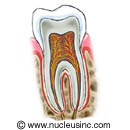Abscessed Tooth
Topic Overview
What is an abscessed tooth?

An abscessed tooth is an infection in or around the tooth. It can be very painful. If the infection isn’t treated, it can spread and you can lose your tooth or have other health problems.
What causes an abscessed tooth?
Damage to the tooth, an untreated cavity (tooth decay), or gum disease can cause an abscessed tooth.
If a cavity isn’t treated, the inside of the tooth (called the pulp) can become infected. Bacteria can spread from the tooth to the tissue around it, creating an abscess.
Gum disease causes the gums to pull away from the teeth, leaving pockets. If food builds up in one of these pockets, bacteria can grow, and an abscess can form. Over time an abscess can cause the bone around the tooth to dissolve.
What are the symptoms?
You may have:
- Throbbing pain, especially when you chew.
- Red, swollen gums.
- A bad, salty taste in your mouth.
- Swelling in your jaw or face.
- A fever.
- A red, swollen bump in your mouth. It may have blood or pus oozing from it.
- A tooth that is very tender or sore to the touch.
Over time as the infection spreads, the bone in your jaw may start to dissolve. When this happens, you may feel less pain, but the infection will still be there. If you lose too much bone, your tooth will become loose and may have to be removed.
If you have a severe toothache, swelling of the gums or face, or drainage of pus, call your dentist right away. You may have an abscessed tooth. If it isn’t treated, the infection could spread and become dangerous.
How is an abscessed tooth diagnosed?
Your dentist will ask about your symptoms and look for swelling and other signs of infection in your mouth. He or she may tap on the tooth and apply heat or cold to the tooth.
Your dentist may also take dental X-rays.
How is it treated?
An abscessed tooth needs treatment right away. Your dentist may:
- Give you antibiotics to kill the bacteria causing the infection.
- Make a hole in the tooth to drain the infection and relieve the pain.
- Do a root canal to remove the infected pulp in the tooth.
- Remove the tooth. This may be needed if you don’t want a root canal, or if you have one and it doesn’t work.
You and your doctor can decide what’s best for you.
To reduce pain and swelling, you can put an ice pack wrapped in a towel against your cheek. You can also try over-the-counter pain medicine, including acetaminophen (such as Tylenol) or ibuprofen (such as Advil or Motrin). Be safe with medicines. Read and follow all instructions on the label. If you smoke or use any kind of tobacco, try not to do so while your tooth is healing.
How can you prevent an abscessed tooth?
The best way to prevent an abscessed tooth is to take good care of your teeth and gums:
- Brush your teeth 2 times a day, in the morning and at night. Use fluoride toothpaste approved by the American Dental Association.
- Use dental floss to clean between your teeth every day.
- See your dentist for regular dental cleanings and checkups.
- Eat a healthy diet, avoid sugary foods and drinks, and limit between-meal snacks.
If you have a very dry mouth, you may be more at risk for deep cavities and tooth infections. To help prevent these, take frequent sips of water, chew sugarless gum, or suck on sugarless candy. Talk to your doctor about medicines that can help.
Current as of: October 3, 2018
Author: Healthwise Staff
Medical Review:Sarah A. Marshall, MD – Family Medicine & Adam Husney, MD – Family Medicine & Martin J. Gabica, MD – Family Medicine & Elizabeth T. Russo, MD – Internal Medicine & Arden G. Christen, DDS, MSD, MA, FACD – Dentistry
This information does not replace the advice of a doctor. Healthwise, Incorporated, disclaims any warranty or liability for your use of this information. Your use of this information means that you agree to the Terms of Use. Learn how we develop our content.


